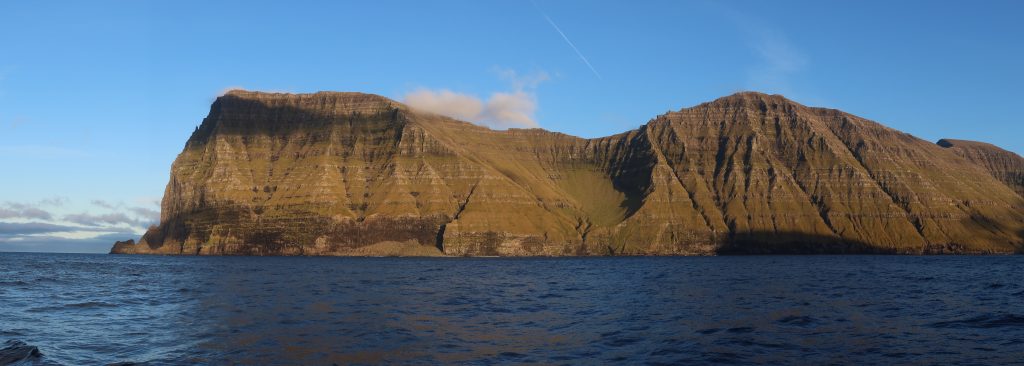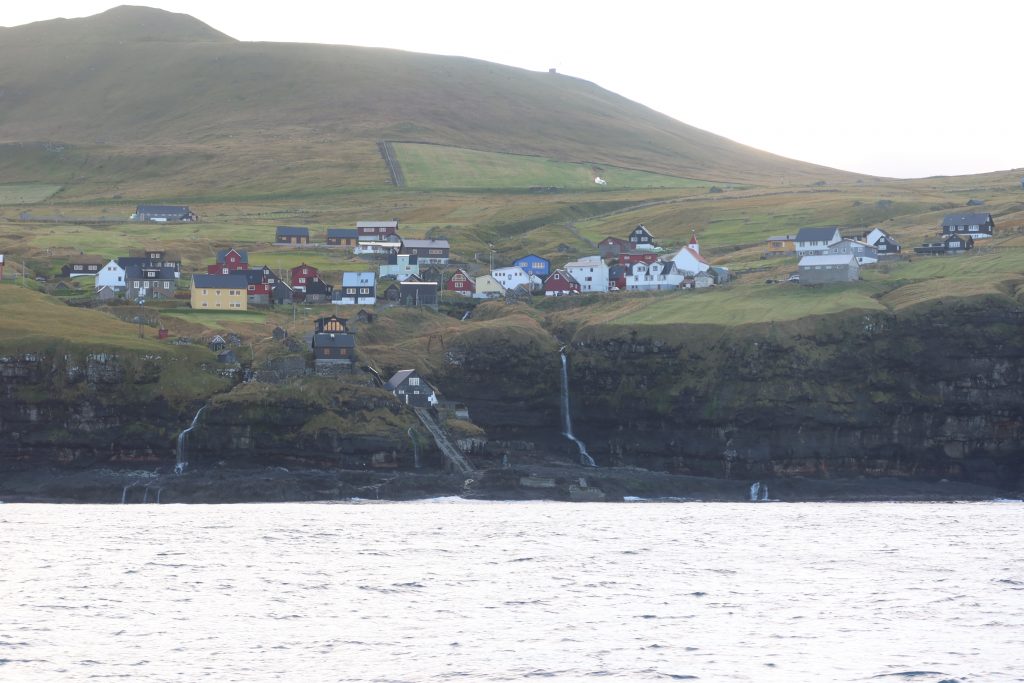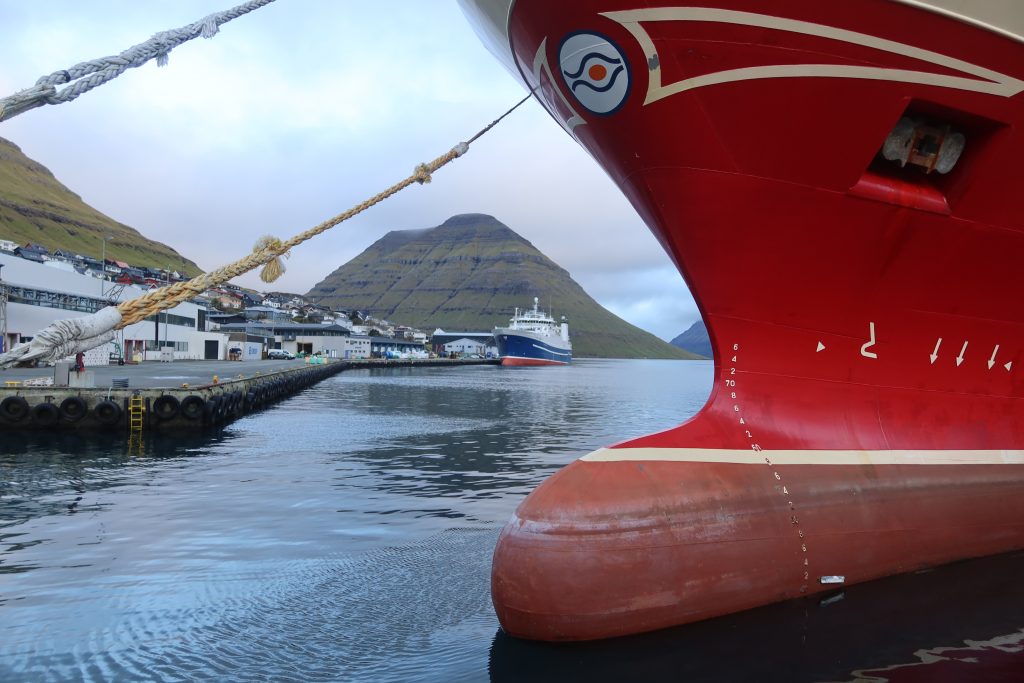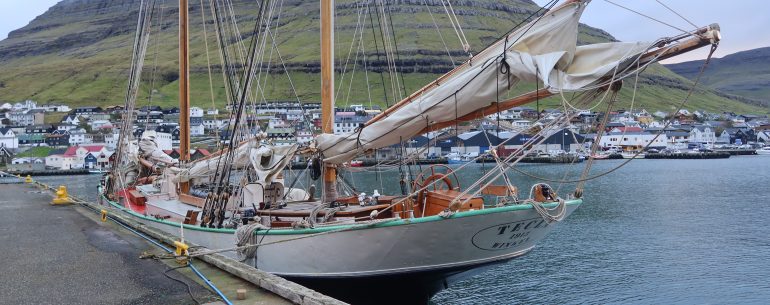One good thing about storms is that they generally go through quite quickly, but despite that we got held up for a couple of days on the Vestmannaeyjar islands. This was because while the storm did go through quite quickly, it was followed by a support act the next day. So, with 30-40 knots forecast the skipper decided to wait another day to set off – a decision we were all quite happy with! Midday on October 10th marked our departure. We hoisted the main and staysail in the harbour and sheeted them centrally and then with the wind blowing us onto the jetty, the skipper left on one spring and very calmly and elegantly nudged the bow out before slipping all the lines – he has definitely done this before! We then headed out and quite quickly hit the Atlantic swell. It had calmed down a great deal, but the first 12-18 hours was a little rolly under engine. Spotting a group of pilot whales more than made up for this though. Then, gradually (although later than forecast) the wind filled in and the main and jib went up and the engine off. Peace at last ….
As the wind built we started making great progress – 8 knots, then 9 and for a couple of watches around 10 knots. This made the crossing quicker than expected and we raised land at lunchtime on the second day, just 48 hours after leaving. We were still 15 miles off the entrance waypoint, but when the weather is clear, the Faroe Islands really stand out. The cliffs we were approaching were some of the tallest sea cliffs around rising sharply out of the sea to a height of over 800 metres. A spectacular introduction to the Faroes. Our landfall was at the northern end of the islands and we headed into the fjord between the islands of Kalsoy and Kunoy. On both islands were small villages nestled in the steep valleys where people farmed the small areas that were fertile, before the cliffs took over and made it unworkable to manage the land at all – a great illustration of the powerful forces that shaped these islands.

One of the villages on Kalsoy was called Mikladalur. Right down close to the edge of the sea was a statue of a selkie (or seal woman). In former times (at least hopefully), seals were thought to be former humans who had sought death in the ocean of their own free will. However, once a year, on Twelfth Night, they could come back on land once again. This meant stripping off their skins so that they could dance the night away. However, a young farmer from Mikladalur had gone down to the beach that night to watch them dance and, predictably (given the nature of these stories), fell deeply in love with one of the selkies. To possess her, he hides the skin meaning that at the end of the night she cannot return to the sea. He forces her to marry him. The story then goers off in a different direction as the farmer was warned not to kill one of the bull seals as that was her husband. Of course he did kill it (wouldn’t have been such a good story otherwise!) and on seeing this, the woman turned into a terrible troll (different legends seem to be converging here ….?) and cursed them with the words: “Here lie the head of my husband with his broad nostrils, the hand of Hárek and the foot of Fredrik! Now there shall be revenge, revenge on the men of Mikladalur, and some will die at sea and others fall from the mountain tops, until there be as many dead as can link hands all round the shores of the isle of Kalsoy!”. Ever since then, any deaths of fishermen at sea have been blamed on the curse of the selkie.

The other claim to fame of Kalsoy is as the lair for villain Lyutsifer Safin’s island in the James Bond film – No Time to Die. The final death scene was filmed on the island and an enterprising local farmer has erected a gravestone for James Bond on the northern tip of the island where filming took place. I hesitate to guess how many photos of this there are on Instagram!
After safely getting past the selkie we carried on down and round the corner into a very sheltered bay and a town called Klaksvik. The town was originally founded in Viking times, but has really started to expand in the 20th century as the fishing fleet of the Faroes has based itself here, the harbour actually being much more sheltered than Tórshavn. The opening of the Leirvík underwater tunnel, the Norðoyatunnilin, in April 2006, sealed Klaksvík as one of the key ports of the Faroes. This road link with the mainland of the Faroe Islands has made it very accessible to all the other islands.

So today has been a day of leisure on the island. Most of the crew headed off on a ferry, then bus, then legs to walk to Kallur lighthouse on Kalsoy, but I decided to walk around locally. I found a nice track (easier walking!) to head up towards Klakkur – the mountain just behind the boat. I didn’t make it quite to the top, but still had a fantastic view back down over Klaksvik and the Tecla moored in the harbour.

From the viewpoint you could also clearly see the football ground and football is a really important part of Faroese culture – particularly in Klaksvik. In 2016, the local team won the Faroe Islands cup and in 2019 they not only won their first title in twenty years, but they managed to reach the second qualifying round of the UEFA Europa League for the first time. 2020 they went one better In 2020, the club, known as KÍ Klaksvík, went one better, becoming the first ever Faroese team to qualify for the Europa League playoff round by beating Dinamo Tbilisi 6–1 This game was apparently watched by 70% of the Klaksvík population. Football is definitely important here!
